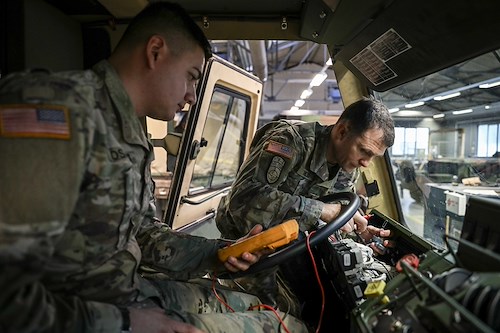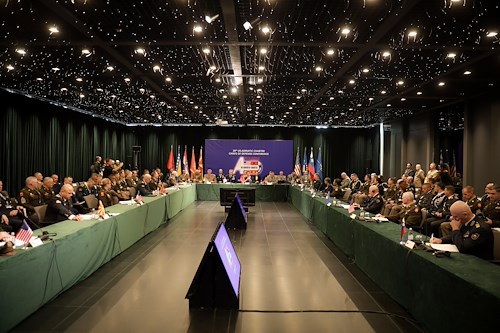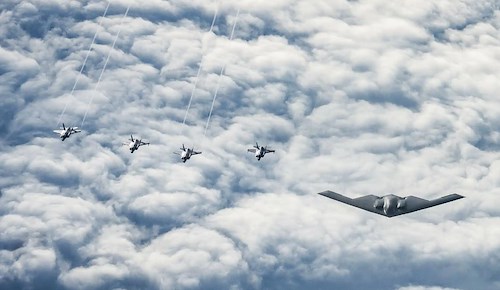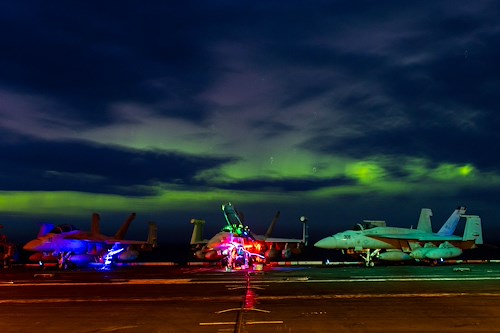Gallery contains 3 images
×
Photo 1 of 3
Vehicle mechanics keep Army rolling throughout European theater
U.S. Army Spc. Stiven Rosales and U.S. Army Master Sgt. Ryan Thiers, both wheeled vehicle mechanics assigned to 21st Theater Sustainment Command, troubleshoot an Army cargo truck at the Daenner Kaserne Motor pool Dec. 18 in Kaiserslautern, Germany. The assigned mechanics are responsible for maintaining vehicle mobility by troubleshooting, fixing and maintaining roughly 60 vehicles at the motor pool. (U.S. Army photo by Pvt. Katelyn Myers)
Photo by: Pvt. Katelyn Myers
Photo 2 of 3
Vehicle mechanics keep Army rolling throughout European theater
U.S. Army Pvt. Cole Herdendorf, a wheeled vehicle mechanic assigned to 21st Theater Sustainment Command examines underneath the hood of an Army cargo truck. Herdendorf is responsible for conducting routine maintenance which includes troubleshooting, replacing and repairing parts, and maintaining vehicles to insure vehicles are mission ready. (U.S. Army photo by Pvt. Katelyn Myers)
Photo by: Pvt. Katelyn Myers
Photo 3 of 3
Vehicle mechanics keep Army rolling throughout European theater
U.S. Army Master Sgt. Ryan Thiers and U.S. Army Spc. Stiven Rosales, both wheeled vehicle mechanics assigned to 21st Theater Sustainment Command, use a maintenance support device at the Daenner Kaserne Motor pool Dec. 18 in Kaiserslautern, Germany. Mechanics use this device as a starting point for troubleshooting, replacing and ordering parts, and utilizing the guides of different electrical systems. (U.S. Army photo by Pvt. Katelyn Myers)
Photo by: Pvt. Katelyn Myers
Warm air carrying the smell of used motor oil and grease circulated through the open bay of the mechanic shop. While one mechanic combed through the colored tangle of wires exposed under the vehicle’s dashboard, another mechanic scanned the various hoses and tubes under the hood of their assigned vehicle.
U.S. Army Master Sgt. Ryan Thiers, battalion maintenance sergeant for Special Troops Battalion, 21st Theater Sustainment Command, works with the mechanics on their basic skills and assists with all inquiries. Troubleshooting vehicles can take days to complete but with help from other knowledgeable soldiers, it will help ensure their assigned vehicles are mission capable promptly.
“What I enjoy most is figuring out what is wrong with the vehicle,” Thiers said. “It’s a reward for all the painstaking hours of troubleshooting and figuring out what the problem is, fixing it, and then it rolls out of the bay.”
Thiers, originally from Texas, joined the Army right out of high school in 2003 as a wheeled vehicle mechanic. With 16 years of experience, perfecting the craft comes in handy when having to troubleshoot the variety of vehicles they are assigned to, Thiers said.
“There are numerous reasons why a vehicle may not be working, and it is the mechanics job to figure out whether it is an electrical, hydraulic or a pneumatic issue,” Thiers said. “You have so many panels with relays and circuit breakers that all control different functions of the vehicle, and it’s time-consuming to troubleshoot that.”
Mechanics may spend eight hours a day or more, over two or three days just troubleshooting a vehicle and checking for voltage on multiple wires or circuit breakers.
U.S. Army Spc. Stiven Rosales joined the Army with some previous experience working on vehicles and he expressed how different it is compared to working on Army vehicles.
“The thing with military vehicles is, to figure out what is wrong you have to go through a whole procedure to see what’s wrong with it,” Rosales said. “It is a much simpler process on the civilian side. There is a computer that can be plugged into POVs and tell you what is wrong.”
Rosales, from Texas, joined the Army when he was 22 and wanted to join since he was young. When he joined in 2014 he was excited that he initially got wheeled vehicle mechanic because he had prior experience working with vehicles. He had no idea how different it would be working on a variety of different military vehicles.
“When you attach to a different unit, let’s say a field artillery unit, where you have tanks, paladins, different tracked vehicles, most of the time you end up cross-training with them and learning the job,” Rosales said. “Even though you’re attached to these units, vehicles need a lot of maintenance, so you learn their job also because, in the end, it’s a team effort.”
Thiers said it’s not uncommon for mechanics to work on vehicles outside their scope of practice throughout their military careers.
“You might be a stryker mechanic or a tank mechanic but guess what, you’re probably going to work on some wheeled vehicles as well,” Thiers said. “Or vice versa, it just depends on how many mechanics we have in the shop and how much equipment is down.”
The hours that the mechanics put into troubleshooting, fixing and maintaining military vehicles aids in mission readiness, and sometimes mechanics do not leave until the job is done, Rosales said.
"Without vehicles a lot of missions would not be able to be accomplished like artillery, troop transportation and supplies,” Rosales said. “Mechanics are the backbone of mobility and the ones that make it happen to keep things moving.”













